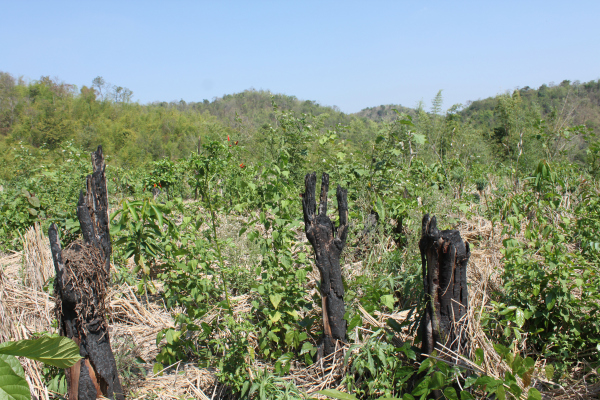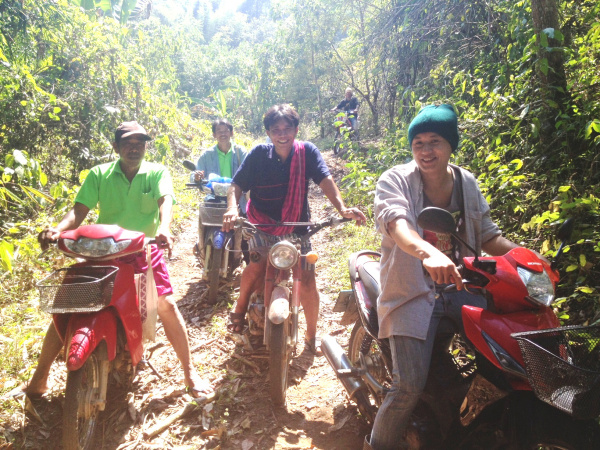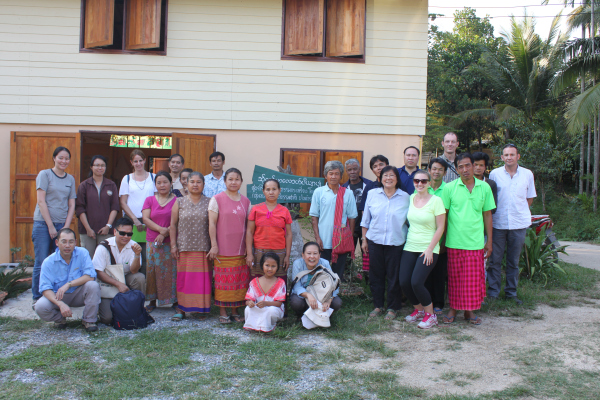Community Forestry: The Next Generation

On 7 February 2013, a group of representatives from RECOFTC’s key donors travelled together with staff members on a 3-hour journey out of Bangkok to Suphanburi province to visit the Huai Hin Dam community and their forest. The group of representatives consisted of members from JICA, Norad, Sida and SDC. The purpose of this field visit was to provide an opportunity for the donor representatives to interact directly with communities that RECOFTC has been working with over the years. It was also an opportunity for them to see the impacts of their support, as well as the challenges that still needed to be addressed. This field visit was tied together with the RECOFTC Annual Review Meeting for donor focal points that was scheduled the following day, at which representatives from the European Commission, Kasetsart University, and USAID also participated.
As the donors saw and remarked upon throughout the day, this community and their forest are unique in certain key ways. As members of the Karen ethnic minority, the Huai Hin Dam community members believe that their forest is sacred. Their deep respect for the forest and awareness of the value of natural resources translate directly into their forest management plan. As healthy forests are a priority for this community, they have been able to successfully and sustainably manage their forest, even through use of the controversial slash and burn, or swidden, method of agriculture.

The donors took note of these unique characteristics, and demonstrated their interest in the community’s history and the steps that they have taken to reach these achievements. It has certainly entailed a great deal of hard work and perseverance, but the effort that this community has put into sustainably managing their forest has paid off and set them apart from many other communities like it. However, the Huai Hin Dam community members also face many of the same challenges that are confronting small, forest-dependent communities across the Asia-Pacific region. One of the most difficult of these challenges is the flight of young people out of the villages to larger cities.
There is a very apparent age gap in the Huai Hin Dam community, which is comprised of plenty of older and middle age adults, as well as young children, but is lacking in young adults. The older generations are understandably quite concerned with this scenario. They are unsure of the best way to preserve their culture and way of life, and to pass this along to their children.

When one of the donor representatives asked a member of the community women’s group who was accompanied by her young daughter about what she would like for her daughter’s future, the woman thoughtfully responded “I would like for her to stay and make use of the home we’ve built here, and to continue building the community…but she won’t be rich,” acknowledging that there were certain things and opportunities that the forest and life in the community couldn’t provide, and that ultimately, it would be up to her daughter to decide her own future.
Many young people from rural communities like Huai Hin Dam are finding the allure of cities and the promise of greater opportunities difficult to resist. And there is certainly a more traditional and less flexible lifestyle on offer in the village. One father spoke proudly about his two daughters, the younger of whom seems to always be saying, “Dad, you’re so old-fashioned.” While this is a sentiment voiced by young people – and a concern for parents – in virtually all societies around the world, this ethnic minority Thai Karen community’s way of life is particularly unique, and the need for it’s preservation particularly urgent.
It’s easy to understand how the young people in communities like Huai Hin Dam, who are connected to the outside, modern world in virtual ways, would like to be connected in more tangible ways. And it’s certainly difficult to imagine how traditional, agricultural-based, rural lifestyles could be more desirable to these young people, who are learning from a distance about the freedoms and new possibilities available in cities. However, an enthusiastic and active, if small number of young adults are returning home from sampling life outside of their home communities.

We had the opportunity to meet one of these young people who made the decision to come back to the Huai Hin Dam community and work to preserve his community’s forest and traditions. Leeh is a member of the Young Seedlings Network, who is using the knowledge and support that he has gained through trainings and exchanges with other Young Seedlings across Thailand to encourage more young people to return to their villages and participate in community life. There are a few occasions throughout the year when most young people do return home to Huai Hin Dam, including New Years celebrations and the first annual rice planting. During these occasions, Leeh creates more engaging opportunities for the young people to get involved, including playing games to make community gatherings and meetings more fun and interactive.

The donor representatives were very impressed with Leeh and his work through the Young Seedlings Network, as well as many other things about the Huai Hin Dam community forest. At the end of the visit, they shared their reflections and feedback with the community, expressing their appreciation for the community’s efforts and perseverance to hold true to their beliefs and incorporate sustainable practices into their forest management plan. The community was encouraged to keep up their efforts, continuing to address the challenges that remain, and be another proven example of the potential and power of community forestry.
One of the last words shared by the representatives was a reminder that all stakeholders – be they donor agencies, international organizations, civil society organizations, or communities – play critical roles and must work together cooperatively to advance community forestry and community-based natural resource management. This is very true for the younger generation of leaders as well, and it will be up to them to continue to strike the balance between ensuring sustainable forest management and adapting to emerging challenges.
RECOFTC’s Young Seedlings Network is working to connect young people like Leeh to allow them to communicate and share their knowledge and experiences to make their difficult task a little bit easier. If you are interested in learning more about the Young Seedling’s Network, please click here.

